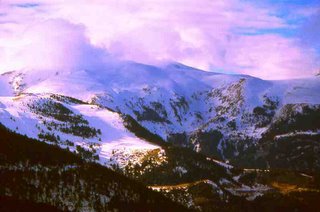
Next week, all eyes will be on Torino and the Italian Alps, where Bode Miller, Daron Rahlves and a fired up U.S. Ski Team threaten to replace the Austrians as kings of the mountain. The Olympics’ downhill events will take place at Sestriere, a posh resort north of Torino (Turin).
Europe’s big-name ski resorts – St. Moritz, Davos, Kitzbuehl, Chamonix and their ilk – sit in the Alps, but there’s also great skiing in that other European mountain range to the west. The Pyrenees offer big runs and big air without the Alps’ cost, crowds and glitz.
And, if you ski in the tiny Pyrenean principality of Andorra, you can have the added experience of visiting three countries in a single day. Wedged between France and Spain, Andorra, which Lonely Planet calls “a nano-nation with more mountains than culture,” is a sea of stunning peaks surrounded by border crossings. Get your passport out of the hotel safe and have it ready, because Spain’s Cerdanya region and its French incarnation, La Cerdagne, are just a mountain road away. Ski, then sightsee.
On a glistening winter day, the kids and I woke up in Spain. We were in Puigcerda, an old Catalan village that sits high above the Cerdanya plain and is ringed by majestic, snow-capped Pyrenees. The hotel breakfast room was filled with Spandexed skiers who’d be boarding the 9:15 bus to La Molina, a Spanish ski resort. Bode Miller would get along with these guys – some of them passed on the coffee and orange juice and fueled themselves instead with red wine. Only time I’ve ever seen wine served at breakfast. As I had a driving date with the 70 twisting kilometers of high altitude asphalt that would take us to Andorra (photo above), I went for the OJ.
Our hotel sat a few yards from the French border, and after a passport check, we were cruising through downtown Bourg-Madame. Just-baked baguettes were stacked in the window of the Boulangerie. Bienvenu a La Cerdagne.
As we wound through ancient stone villages, we tuned in radio stations broadcasting in French, Spanish and Catalan. We threaded our way up into the mountains, then entered a high tunnel. When we drove out the other side, we found Pyrenees practically in the car with us. We’d been deposited into an ice-blue miracle world of snow and sunlit summits. We were still in France, but about to enter Andorra at one of the planet’s most beautiful border crossings.
While the border guard checked our documents, we were checking out the scene just in front of us. Pas de la Casa, Andorra’s biggest ski area and highest lift-served terrain, filled the windshield. A 360-degree vista wrapped around our car, and a good 200 degrees of it was devoted to the skiing life: slopes of deep powder dotted with little figures having fun on fiberglass; hotels, condos, shops, bars, restaurants; tan, ski-toting tourists in mirrored sunglasses wandering the main street; cars with full ski racks sniffing out parking spaces. And everywhere, chairs cycling skiers and boarders up into the air to the tops of various peaks, all lit like golden fingers in the sun.
We didn’t ski. When I travel alone with the kids, I strap on a mother's super-sensitive set of risk antennae. While skiing at Pas de la Casa looked like it would be heaven on Earth, I imagined the transatlantic phone call: “Hi Mike. It’s me. I’m in traction in Andorra. Can you fly over here and pick up the kids? What? Your passport’s expired? Hmmm. I’ll have to see if they can live in the hospital room with me until you get it renewed...”
We did, however, schuss. On our ski bums. We slid down a slope on vinyl raincoats I’d stashed in the trunk. Then we drove to Spain.
